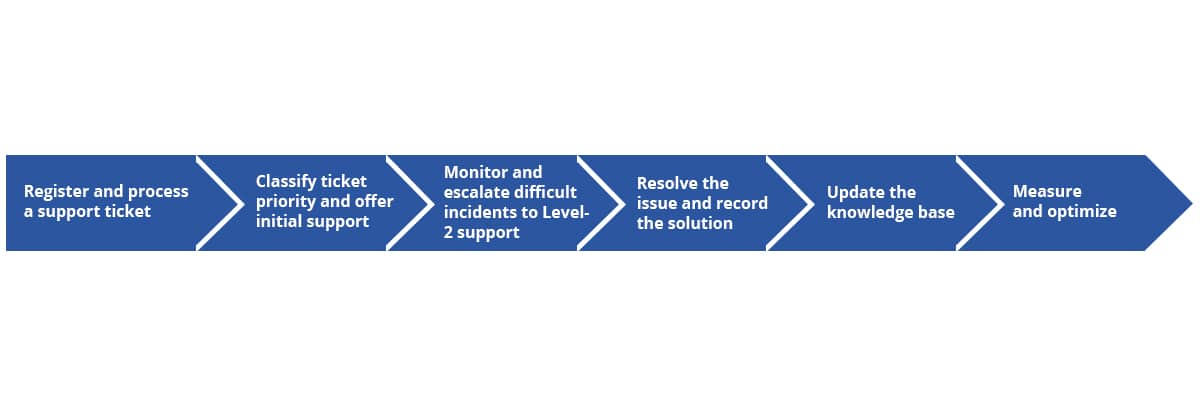Have you ever submitted an IT service request and then sat, frustrated and waiting, for what seemed like way too long? Without transparent communication about how the request was being dealt with?
It doesn’t have to be that way.
IT service requests are vitally important and should be responded to quickly and with transparency. Yes, as an IT company, we assist with many components of IT. Strategy. Roadmap development. Project design. Implementation. Hardware and software procurement. Optimization. And more.
You get the idea.
Still, when most people think of IT service, before they think of any of those roles, they think of something simpler: the role that an IT provider fills when a user makes a service request – the person on the other end of the phone or behind the computer.
The reality is that an IT company’s ability to respond to service requests is the ultimate measure of their ability to serve well.
It’s hard (although not impossible!) to quantify what’s gained and lost through IT strategy; it’s easy to count the minutes an employee is sitting and waiting for IT help to arrive.
Accordingly, if you’re considering working with an IT service, one of the key questions you’ll want to ask is, what happens when I make a service request?
And you should like the answer you get.
The process varies from IT company to IT company, of course. But, at Complete Network, we’ve designed our IT service for rapid responses and quick resolution. When you make an IT service request with us, here’s what happens on our side.

That’s the internal version of the IT service request process. In this article, we’ll walk through the outcomes of this process from the user perspective.
One of the key complaints we hear from companies looking to switch providers is that “IT responds too slowly.”
At Complete Network, we ensure that all requests are addressed as quickly as possible; it’s a point of pride for us, and a consistent point of appreciation for our clients.
The exact nature of the IT response depends on how a service request is submitted. If a ticket is registered through our support portal, for instance, it’s dealt with there (with additional channels opened as needed). If a phone call comes in, it’s answered promptly by a real, knowledgeable, and friendly human.
You’re never left waiting and wondering about the status of your request.
Once your IT service request is received and responded to, the next step is either resolution or escalation.
If the responding technician can take care of the issue, they will as soon as possible. Most issues are resolved at this first level. However, if problems are complex or require specialized knowledge, they may need to be escalated to what’s known as a Level-2 technician, or even further on to Level-3 support.
If this is the case, our clearly documented processes ensure that the right engineers are brought on to address things as efficiently as possible. Users are kept in the loop throughout the process.
Once escalation happens, any additional support is provided so that the issue is resolved quickly and for good.
We have best-in-class IT support platforms that enable many problems to be solved remotely; however, if needed, our engineers are available to quickly deliver support on-site, too.
Access to this level of support is one benefit of working with a deep team of IT experts – we have people who specialize in a wide range of technologies. The bottom line is that you’ll get the help you need.
After service is delivered, users have the opportunity to rate the quality of the interaction and provide any feedback.
We’re proud to relay that 98.7% of our customer service reviews are rated as positive. However, if there are any questions or concerns, we note them carefully. We’re always seeking to improve our processes, which is why we regularly have internal audits to test and optimize ticket escalation and resolution metrics.
Finally, after you submit an IT service request and the issue is resolved, we’ll fully document the event and update our knowledge base. This way, any future work takes the previous issue into account.
We’ll follow up based on the status of the resolution, and, every six months, our vCIOs meet with our clients to review scorecards, reducing the potential for recurring technology issues.
Our goal is to ensure that issues are fixed at the source so that they don’t recur or lead to other problems over time.
There are few things more frustrating than submitting an IT service request and feeling ignored.
When you work with us, you won’t have to experience that.
Complete Network is a different kind of IT company. For over 20 years, we’ve been working with clients in Albany, New York, Charlotte, North Carolina, and Bluffton, South Carolina to ensure that their technology and staff are fully supported – no matter how complex their needs.
If you’d like to learn about Complete Network, or how our IT service consistently earns glowing praise from clients, we’d be happy to answer your questions any time. Call us at 1-(844) 426-7844.
In an ideal world, technology would be a consistent source of competitive advantage and benefit for small and midsized businesses. The reality is that many fail to realize that confidence.
Without the right resources and support, even a highly skilled technology team can become overwhelmed by the growing list of technology management duties. When important tasks get neglected, it creates ripple effects throughout an organization that damage productivity and efficiency.
The co-managed IT services model solves these problems by providing your existing IT team with all the support and resources they need to successfully plan, manage, and defend your network technology.
This guide covers:
This will close in 0 seconds
This will close in 0 seconds